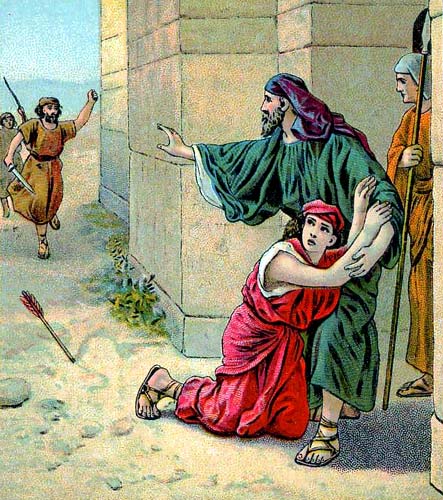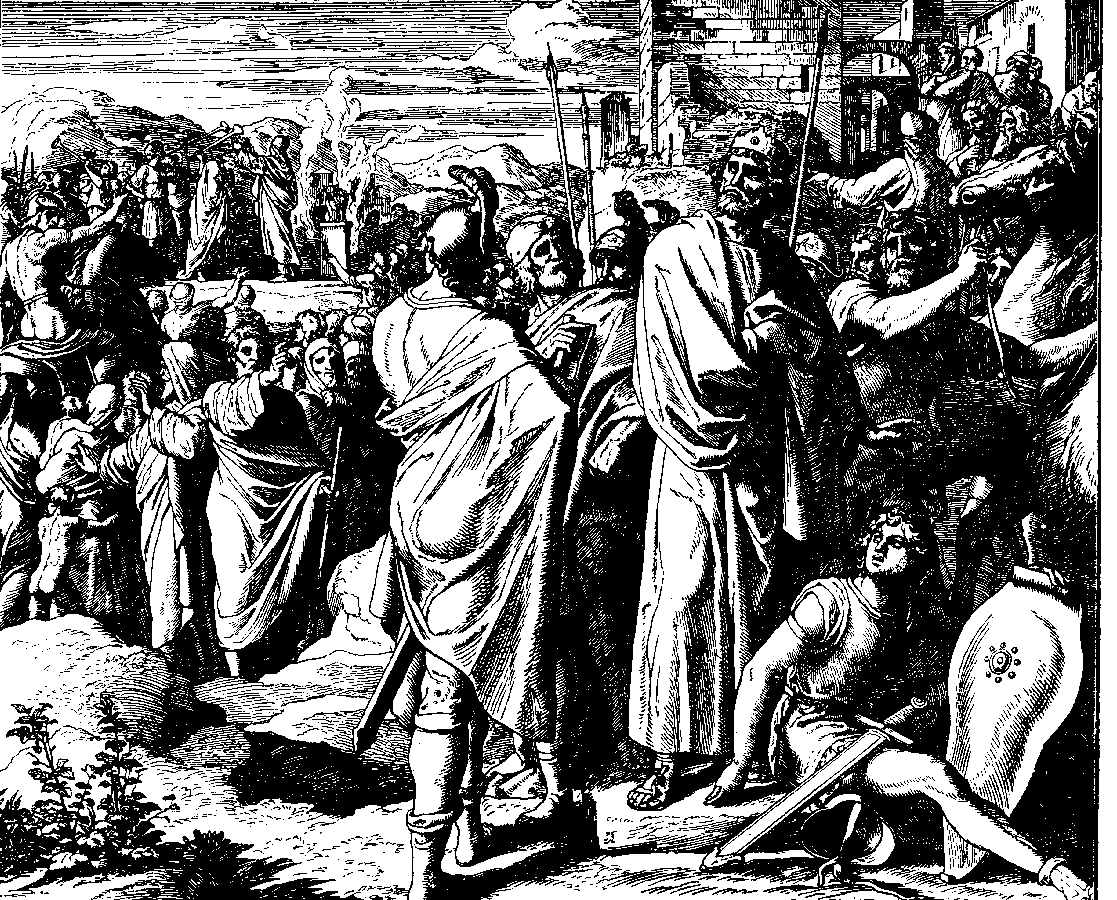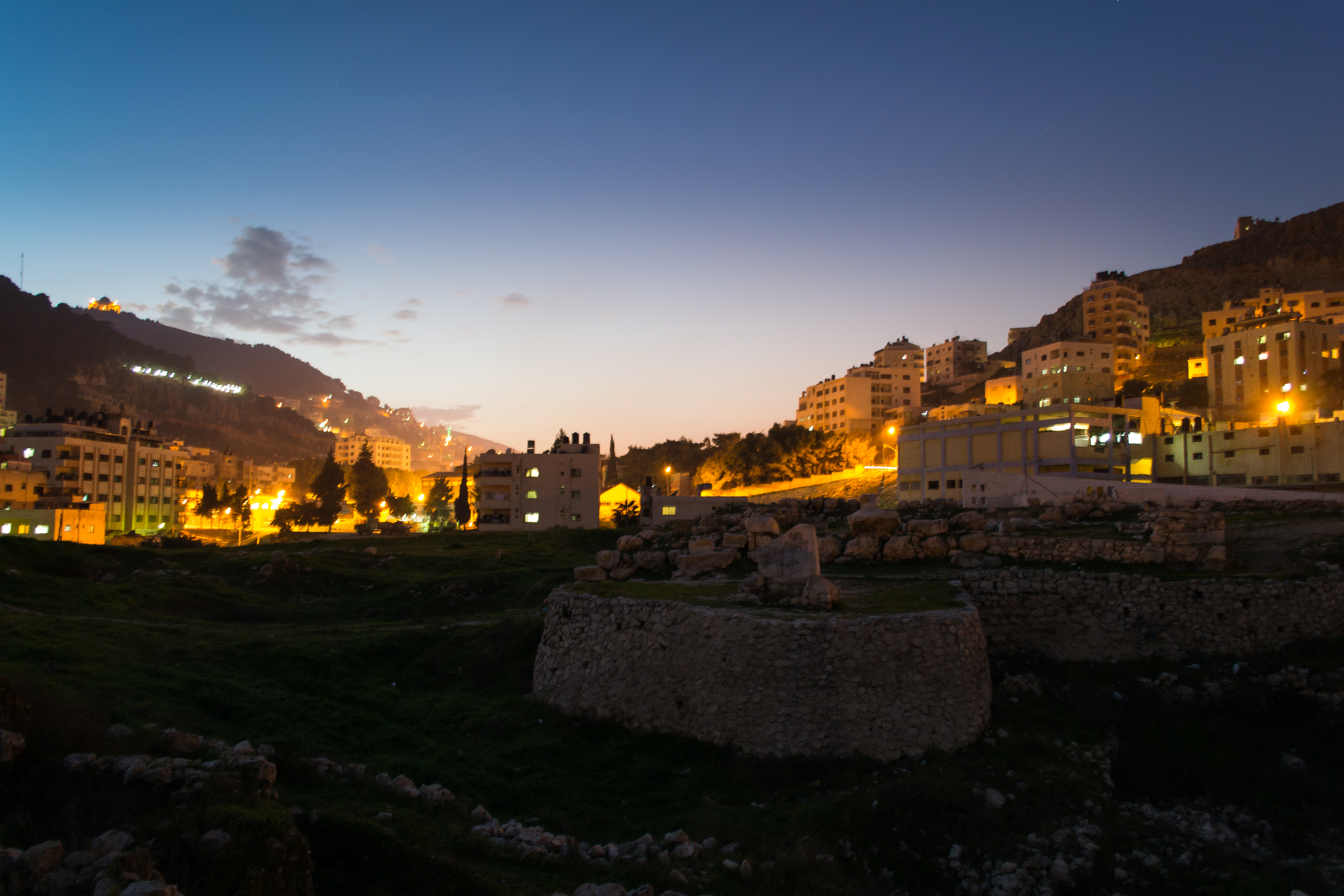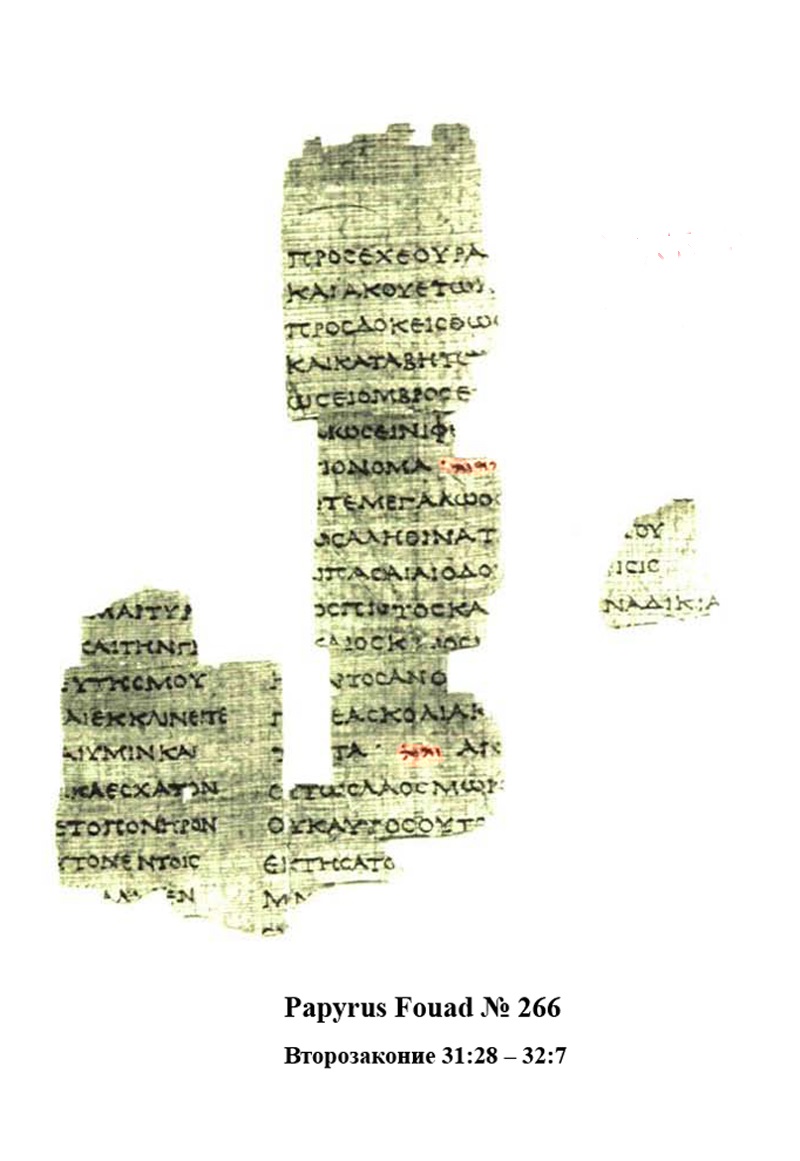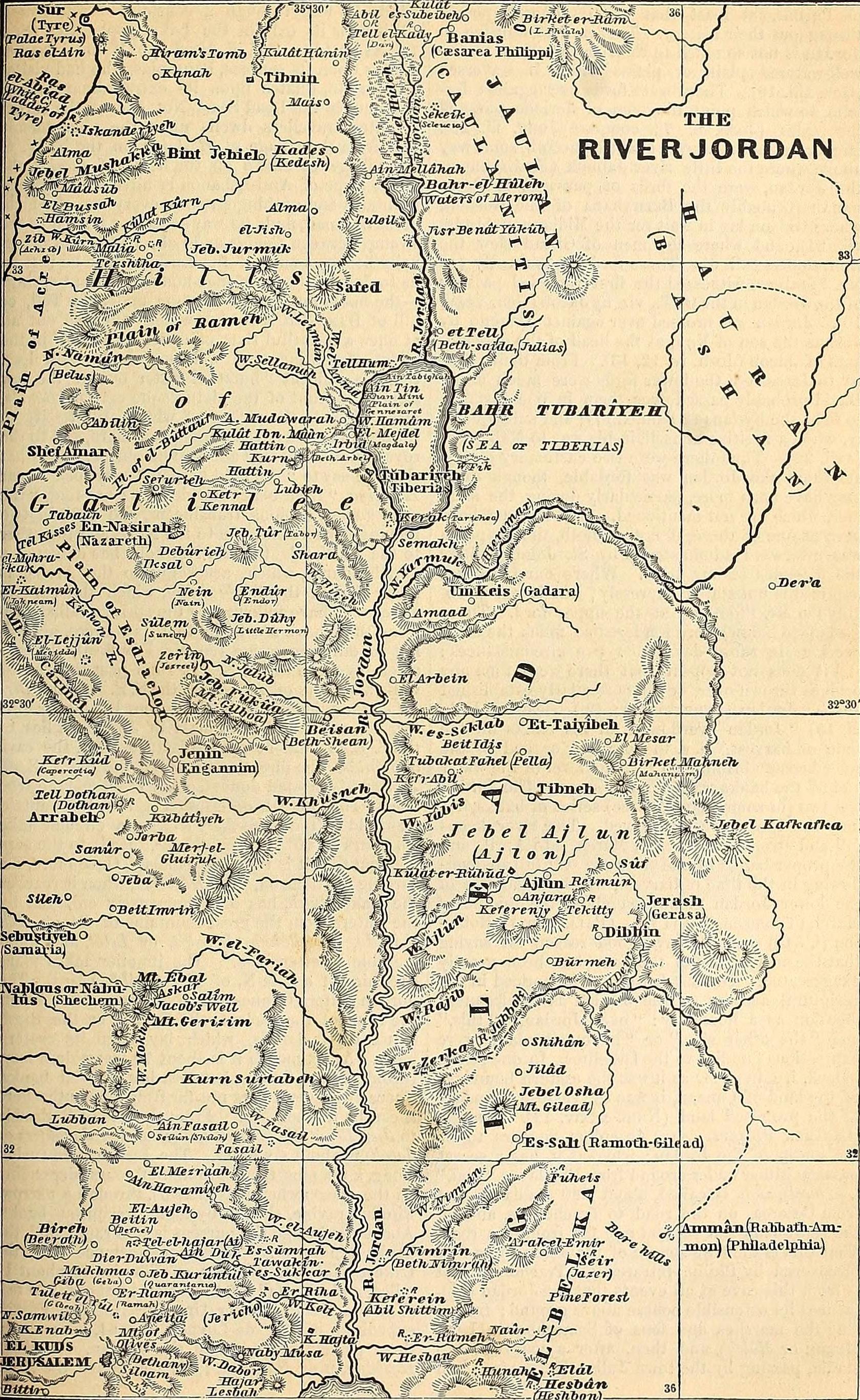|
Levitical Cities
In the Hebrew Bible, the Levitical cities were 48 cities in ancient Israel set aside for the tribe of Levi, who were not allocated their own territorial land when the Israelites entered the Promised Land. Numbers 35:1-8 relates God's command to Moses to establish 48 cities for the Levites, of which six would also function as Cities of Refuge to which manslayers could flee. Each settlement was to comprise a walled city and the common land around it for pasture, measured radially as one thousand cubits (about ) in each direction, or as a square measuring two thousand cubits (about ) along each side. The land for the cities was to be "donated" by the host tribe and was allocated to the Levites according to their tribal sub-divisions. 13 cities were for the Aaronites. 13 cities were for the Gershonites. 10 cities were for the Kohathites. 12 cities were for the Merarites. The six cities which were to be Cities of Refuge were Golan, Ramoth, and Bezer, on the east of the Jordan ... [...More Info...] [...Related Items...] OR: [Wikipedia] [Google] [Baidu] |
Cities Of Refuge
The cities of refuge ( ''‘ārê ha-miqlāṭ'') were six Levitical towns in the Kingdom of Israel and the Kingdom of Judah in which the perpetrators of accidental manslaughter could claim the right of asylum. Maimonides, invoking talmudic literature, expands the city of refuge count to all 48 Levitical cities. Outside of these cities, blood vengeance against such perpetrators was allowed by law. The Bible names the six cities of refuge as follows: Golan, Ramoth, and Bosor to the east (left bank) of the Jordan River; and Kedesh, Shechem, and Hebron on the western (right) side. Biblical regulations In Numbers In the Book of Numbers, the laws concerning the cities of refuge state that, once he had claimed asylum, a perpetrator had to be taken from the city and put on trial; if the trial found that the perpetrator was innocent of murder, then the perpetrator had to be returned under guard (for their own protection) to the city in which they had claimed asylum. This la ... [...More Info...] [...Related Items...] OR: [Wikipedia] [Google] [Baidu] |
Golan
Golan (; ) is the name of a biblical town later known from the works of Josephus (first century CE) and Eusebius (''Onomasticon'', early 4th century CE). Archaeologists localize the biblical city of Golan at Sahm el-Jaulān, a Syrian village east of Wadi ar- Ruqqad in the Daraa Governorate, where early Byzantine ruins were found. Israeli historical geographer, Zev Vilnay, tentatively identified the town Golan with the Goblana (Gaulan) of the Talmud which he thought to be the ruin ''ej-Jelêbîne'' on the Wâdy Dabûra, near the Lake of Huleh, by way of a corruption of the site's original name. According to Vilnay, the village took its name from the district Gaulanitis (Golan). The ruin is not far from the Daughters of Jacob Bridge. The traces of the town were described by G. Schumacher in the late 19th-century as being "a desert ruin", having "no visible remains of importance, but avingthe appearance of great antiquity." In the Grecised form Gaulanitis (), it is the name ... [...More Info...] [...Related Items...] OR: [Wikipedia] [Google] [Baidu] |
Tribe Of Benjamin
According to the Torah, the Tribe of Benjamin () was one of the Twelve Tribes of Israel. The tribe was descended from Benjamin, the youngest son of the Patriarchs (Bible), patriarch Jacob (later given the name Israel) and his wife Rachel. In the Samaritan Pentateuch the name appears as ''Binyamēm'' (Samaritan Hebrew: ). The Tribe of Benjamin, located to the north of the Tribe of Judah but to the south of the later Kingdom of Israel (Samaria), Kingdom of Israel, is significant in biblical narratives as a source of various Israelites, Israelite leaders, including the first Israelite king, Saul, as well as earlier tribal leaders in the period of the Hebrew Bible judges, Judges. In the period of the Judges, they feature in an episode in which a civil war results in their near-extinction as a tribe. After the brief period of the Kingdom of Israel (united monarchy), United Kingdom of Israel, Benjamin became part of the southern Kingdom of Judah following the split into two kingdoms. A ... [...More Info...] [...Related Items...] OR: [Wikipedia] [Google] [Baidu] |
Tribe Of Asher
According to the Hebrew Bible, the Tribe of Asher was one of the Tribes of Israel descended from Asher (), the eighth son of Jacob. It is one of the ten lost tribes. Biblical narrative According to the biblical Book of Joshua, following the completion of the conquest of Canaan by the Israelite tribes, Joshua allocated the land among the twelve tribes. According to biblical scholar Kenneth Kitchen, one should date this conquest slightly after 1200 BC.Kitchen, Kenneth A. (2003), "On the Reliability of the Old Testament" (Grand Rapids, Michigan. William B. Eerdmans Publishing Company)() This is referred to as a 'late date' with the main alternative of around 1500 BC referred to as the 'early date' for both the Exodus and conquest of Canaan.Waltke, Bruce (1990), "The Date of the Conquest" (Westminster Theological Journal 52.2 (Fall 1990): 181-200./ref> In opposition to both of these views, many critical scholars hold that the conquest of Joshua as described in the Book of Joshua never ... [...More Info...] [...Related Items...] OR: [Wikipedia] [Google] [Baidu] |
1 Chronicles
The Book of Chronicles ( , "words of the days") is a book in the Hebrew Bible, found as two books (1–2 Chronicles) in the Christian Old Testament. Chronicles is the final book of the Hebrew Bible, concluding the third section of the Jewish Tanakh, the Ketuvim ("Writings"). It contains a genealogy starting with Adam and a history of ancient Judah and Israel up to the Edict of Cyrus in 539 BC. The book was translated into Greek and divided into two books in the Septuagint in the mid-3rd century BC. In Christian contexts Chronicles is referred to in the plural as the Books of Chronicles, after the Latin name given to the text by Jerome, but is also referred to by its Greek name as the Books of Paralipomenon. In Christian Bibles, they usually follow the two Books of Kings and precede Ezra–Nehemiah, the last history-oriented book of the Protestant Old Testament. Summary The Chronicles narrative begins with Adam, Seth and Enosh, and the story is then carried forward, almost ... [...More Info...] [...Related Items...] OR: [Wikipedia] [Google] [Baidu] |
Tribe Of Benjamin 1
The term tribe is used in many different contexts to refer to a category of human social group. The predominant worldwide use of the term in English is in the discipline of anthropology. The definition is contested, in part due to conflicting theoretical understandings of social and kinship structures, and also reflecting the problematic application of this concept to extremely diverse human societies. Its concept is often contrasted by anthropologists with other social and kinship groups, being hierarchically larger than a lineage or clan, but smaller than a chiefdom, ethnicity, nation or state. These terms are similarly disputed. In some cases tribes have legal recognition and some degree of political autonomy from national or federal government, but this legalistic usage of the term may conflict with anthropological definitions. In the United States (US), Native American tribes are legally considered to have "domestic dependent nation" status within the territorial Unit ... [...More Info...] [...Related Items...] OR: [Wikipedia] [Google] [Baidu] |
Hebron
Hebron (; , or ; , ) is a Palestinian city in the southern West Bank, south of Jerusalem. Hebron is capital of the Hebron Governorate, the largest Governorates of Palestine, governorate in the West Bank. With a population of 201,063 in the city limits, the adjacent metropolitan area within the governorate is home to over 700,000 people. Hebron spans across an area of . It is the List of cities in Palestine, third largest city in the country after Gaza City, Gaza and East Jerusalem. The city is often considered one of the Four Holy Cities, four holy cities in Judaism as well as in Islam and Christianity. It is considered one of the oldest cities in the Levant. According to the Bible, Abraham settled in Hebron and bought the Cave of the Patriarchs as burial place for his wife Sarah. Biblical tradition holds that the patriarchs Abraham, Isaac, and Jacob, along with their wives Sarah, Rebecca, and Leah, were buried in the cave. The city is also recognized in the Bible as the ... [...More Info...] [...Related Items...] OR: [Wikipedia] [Google] [Baidu] |
Shechem
Shechem ( ; , ; ), also spelled Sichem ( ; ) and other variants, was an ancient city in the southern Levant. Mentioned as a Canaanite city in the Amarna Letters, it later appears in the Hebrew Bible as the first capital of the Kingdom of Israel (Samaria), Kingdom of Israel following the split of the Kingdom of Israel (united monarchy), United Monarchy. According to , it was located in the tribal territorial allotment of the tribe of Ephraim. Shechem declined after the fall of the Kingdom of Israel (Samaria), northern Kingdom of Israel. The city later regained its importance as a prominent Samaritans, Samaritan center during the Hellenistic Palestine, Hellenistic period. Traditionally associated with the city of Nablus, Shechem is now identified with the nearby site of Tell Balata in the Balata al-Balad suburb of the West Bank. Geographical position Shechem's position is indicated in the Hebrew Bible: it lay north of Bethel and Shiloh (Biblical city), Shiloh, on the high road ... [...More Info...] [...Related Items...] OR: [Wikipedia] [Google] [Baidu] |
Kedesh
Kedesh (alternate spellings: Qedesh, Cadesh, Cydessa) was an ancient Canaanite and later Israelite settlement in Upper Galilee, mentioned several times in the Hebrew Bible. Its remains are located in Tel Kedesh, northeast of the modern Kibbutz Malkiya in Israel on the Israeli- Lebanese border.Negev & Gibson, eds. (2001), p. 278. The settlement is first documented in the Book of Joshua as a Canaanite citadel conquered by the Israelites and designated as a Levitical city and City of Refuge. In the 8th century BCE, it was captured by Tiglath-Pileser III of Assyria and its inhabitants deported. Jewish tradition holds that Deborah, Barak and Jael were buried near Kedesh. During the 5th century BCE, it possibly became the capital of the Achaemenid province of Upper Galilee. In the Hellenistic period, Kedesh was the site of battles involving Jonathan Apphus and Seleucid king Demetrius II. In the Roman period, Josephus records Jewish attacks on Kedesh during the First Jewish–Ro ... [...More Info...] [...Related Items...] OR: [Wikipedia] [Google] [Baidu] |
Book Of Joshua
The Book of Joshua is the sixth book in the Hebrew Bible and the Old Testament, and is the first book of the Deuteronomistic history, the story of Israel from the conquest of Canaan to the Babylonian captivity, Babylonian exile. It tells of the campaigns of the Israelites in central, southern and northern Canaan, the destruction of their enemies, and the division of the land among the Twelve Tribes of Israel, Twelve Tribes, framed by two set-piece speeches, the first by God commanding the conquest of the land, and, at the end, the second by Joshua warning of the need for faithful observance of the Law (''torah'') revealed to Moses. The scholarly consensus is that the Book of Joshua is not a reliable historical account, with Archaeology, archaeological evidence contradicting its claims of a swift, violent conquest of Canaan. The earliest parts of the book are possibly chapters 2–11, the story of the conquest; these chapters were later incorporated into an early form of Joshua li ... [...More Info...] [...Related Items...] OR: [Wikipedia] [Google] [Baidu] |
Book Of Deuteronomy
Deuteronomy (; ) is the fifth book of the Torah (in Judaism), where it is called () which makes it the fifth book of the Hebrew Bible and Christian Old Testament. Chapters 1–30 of the book consist of three sermons or speeches delivered to the Israelites by Moses on the Plains of Moab, shortly before they enter the Promised Land. The first sermon recounts the Moses#The years in the wilderness, forty years of wilderness wanderings which had led to that moment and ends with an exhortation to observe the law. The second sermon reminds the Israelites of the need to follow Yahweh and the laws (or teachings) he has given them, on which their possession of the land depends. The third sermon offers the comfort that, even should the nation of Israel prove unfaithful and so lose the land, with repentance all can be restored. The final four chapters (31–34) contain the Song of Moses, the Blessing of Moses, and the narratives recounting the passing of the mantle of leadership from Mose ... [...More Info...] [...Related Items...] OR: [Wikipedia] [Google] [Baidu] |
Jordan River
The Jordan River or River Jordan (, ''Nahr al-ʾUrdunn''; , ''Nəhar hayYardēn''), also known as ''Nahr Al-Sharieat'' (), is a endorheic river in the Levant that flows roughly north to south through the Sea of Galilee and drains to the Dead Sea. The river passes by or through Jordan, Syria, Israel, and the Palestinian territories. Jordan and the Israeli-occupied Golan Heights border the river to the east, while Israel and the Israeli-occupied West Bank lie to its west. Both Jordan and the West Bank derive their names in relation to the river. The river holds major significance in Judaism and Christianity. According to the Bible, the Israelites crossed it into the Promised Land and Jesus of Nazareth was baptized by John the Baptist in it. Etymology Several hypotheses for the origin of most of the river's names in modern languages (e.g., Jordan, Yarden, Urdunn), one is that it comes from Semitic 'Yard, on' 'flow down' <√ירד reflecting the river's declivity, possibly a ... [...More Info...] [...Related Items...] OR: [Wikipedia] [Google] [Baidu] |
